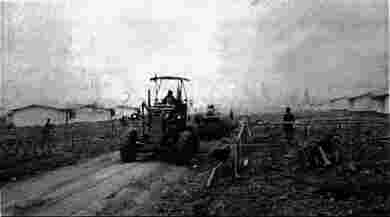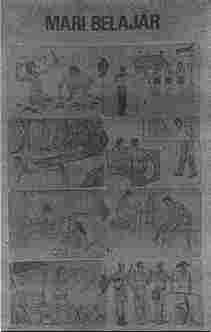
Transmigration
![]() Over three quarters of a million people have resettled in West Papua under
the government's Transmigration program. The majority are from the islands
of Java and Sulawesi, but any Indonesian citizen and his family are able to
take part in the scheme and receive assistance for transportation and
establishment. As either "spontaneous", or sponsored Transmigrasi, most
have been resettled in large settlements along the Indonesia / PNG border,
near the large towns of Jayapura and Merauke, or in the forestry / mining
areas of Sorong and Timika. The Trans-Irian Highway will soon open up to
Transmigration the previously isolated rural, and more densely populated,
central highlands, a region where a mining concession of over 3 million hectares
has been issued by the Indonesian government.
Over three quarters of a million people have resettled in West Papua under
the government's Transmigration program. The majority are from the islands
of Java and Sulawesi, but any Indonesian citizen and his family are able to
take part in the scheme and receive assistance for transportation and
establishment. As either "spontaneous", or sponsored Transmigrasi, most
have been resettled in large settlements along the Indonesia / PNG border,
near the large towns of Jayapura and Merauke, or in the forestry / mining
areas of Sorong and Timika. The Trans-Irian Highway will soon open up to
Transmigration the previously isolated rural, and more densely populated,
central highlands, a region where a mining concession of over 3 million hectares
has been issued by the Indonesian government.
![]() The overall effect of the
influx of immigrant unskilled and skilled labour has been to severely limit
opportunities for employment of Irianese in private sector activities. Unless
positive employment policies in favour of the indigenous population are pursued,
continued social conflict would appear to be unavoidable.
The overall effect of the
influx of immigrant unskilled and skilled labour has been to severely limit
opportunities for employment of Irianese in private sector activities. Unless
positive employment policies in favour of the indigenous population are pursued,
continued social conflict would appear to be unavoidable.
![]() In many regions of
West Papua the indigenous people, forest dwellers such as the Moi and Asmat,
are losing their traditional way of life not only to deforestation and mining
projects but also to the recently revised Transmigration policy. This policy
encourages forest people to resettle in camps where they will be granted a small
area of land to produce their everyday necessities. In the case of the Amungme,
Dani and Mbua regions, this has involved the resettlement of people to lower
altitudes, away from prospective mining zones, where resistance to disease such
as malaria is low. Almost a million hectares have already been cleared and
allocated for settlements, with lucrative contracts awarded for clearing and
construction. A Canadian company, Lavalin, has been contracted to conduct the
surveying. The World Bank has been the major financer of the scheme.
In many regions of
West Papua the indigenous people, forest dwellers such as the Moi and Asmat,
are losing their traditional way of life not only to deforestation and mining
projects but also to the recently revised Transmigration policy. This policy
encourages forest people to resettle in camps where they will be granted a small
area of land to produce their everyday necessities. In the case of the Amungme,
Dani and Mbua regions, this has involved the resettlement of people to lower
altitudes, away from prospective mining zones, where resistance to disease such
as malaria is low. Almost a million hectares have already been cleared and
allocated for settlements, with lucrative contracts awarded for clearing and
construction. A Canadian company, Lavalin, has been contracted to conduct the
surveying. The World Bank has been the major financer of the scheme.
![]() Transmigration is part of the Indonesian government's stated policy of
assimilating indigenous people with the goal of forging a single national
identity. The Indonesian government has sought to alleviate the population
pressure on Java by addressing the imbalance in population density with other
so-called "outer" islands, such as West Papua, where the transmigration program
is now concentrated.
Transmigration is part of the Indonesian government's stated policy of
assimilating indigenous people with the goal of forging a single national
identity. The Indonesian government has sought to alleviate the population
pressure on Java by addressing the imbalance in population density with other
so-called "outer" islands, such as West Papua, where the transmigration program
is now concentrated.
![]() It is projected that by the year 2010 the population of
West Papua will have grown to between 2.6 and 3.9 million. This will largely
be due to transmigration, both government funded and "spontaneous", and subsequent
industrialisation resulting from Jakarta's "Eastward Development Policy" of 1990.
Non-Irianese born already make up over 70 per cent of the province's urban
population. In the current five year plan the province will receive 52,000
families of transrnigrants. It is clear that a major consequence of
Transmigration to West Papua is the large-scale displacement of the indigenous
population from their traditional lands.
It is projected that by the year 2010 the population of
West Papua will have grown to between 2.6 and 3.9 million. This will largely
be due to transmigration, both government funded and "spontaneous", and subsequent
industrialisation resulting from Jakarta's "Eastward Development Policy" of 1990.
Non-Irianese born already make up over 70 per cent of the province's urban
population. In the current five year plan the province will receive 52,000
families of transrnigrants. It is clear that a major consequence of
Transmigration to West Papua is the large-scale displacement of the indigenous
population from their traditional lands.
![]() Clause 17 of Indonesia's Basic Forestry
Act of 1967 says:
Clause 17 of Indonesia's Basic Forestry
Act of 1967 says:
"The rights of traditional law communities may not be allowed
to stand in the way of transmigration sites",
![]() and Article 2 of the Basic Agrarian
Law of 1960 says that:
and Article 2 of the Basic Agrarian
Law of 1960 says that:
"... it is not permissible ... for a community based on
its traditional rights, to refuse to allow forest land to be cleared on a large
and organised scale for the implementation of large-scale projects undertaken in
the framework of plans to increase the production of foodstuffs and to shift the
inhabitants".
![]() Not only do the indigenous people have no right to resist appropriation
of their land for transmigrants or industry, but they are also likely to receive
little or no compensation for it. For example, at Arso and other places in the
vicinity of Jayapura, "the local people have received no compensation for any
of the land which they have been obliged to relinquish. Furthermore, if they resist
the demand for their land, they are labeled OPM, which means future military
harassment and abuse".
Not only do the indigenous people have no right to resist appropriation
of their land for transmigrants or industry, but they are also likely to receive
little or no compensation for it. For example, at Arso and other places in the
vicinity of Jayapura, "the local people have received no compensation for any
of the land which they have been obliged to relinquish. Furthermore, if they resist
the demand for their land, they are labeled OPM, which means future military
harassment and abuse".
![]() According to the Minister of Transmigration, "the surrender
of land for the needs of transmigration is not accompanied by compensation
(ganti rugi) but only by granting recognition, namely a certificate of recognition
of right .... Recognition can take various forms, even the form of something with
no economic value such as the holding of a traditional ceremony, the presentation
of agricultural implements, a church or a mosque or other social facilities."
According to the Minister of Transmigration, "the surrender
of land for the needs of transmigration is not accompanied by compensation
(ganti rugi) but only by granting recognition, namely a certificate of recognition
of right .... Recognition can take various forms, even the form of something with
no economic value such as the holding of a traditional ceremony, the presentation
of agricultural implements, a church or a mosque or other social facilities."
![]() The
stated goal of transmigration is, according to the former Minister, "to integrate
all the ethnic groups into one nation ... the different ethnic groups will in the
long run disappear because of integration ... and there will be one kind of man ..."
The official view is that the transmigration program is beneficial to the native
inhabitants because it enables them to "learn from the Javanese". It has been
argued that the program must be hurried along as a means of transferring agricultural
knowledge while integrating the indigenous Irianese into the mainstream of the
nation. On the other hand, critics of the program argue that many of the Irianese
people are not ready for, nor do they desire to enter into, an imported community
of agriculturalists, forced without their consent to forego their traditional land
rights and culture.
The
stated goal of transmigration is, according to the former Minister, "to integrate
all the ethnic groups into one nation ... the different ethnic groups will in the
long run disappear because of integration ... and there will be one kind of man ..."
The official view is that the transmigration program is beneficial to the native
inhabitants because it enables them to "learn from the Javanese". It has been
argued that the program must be hurried along as a means of transferring agricultural
knowledge while integrating the indigenous Irianese into the mainstream of the
nation. On the other hand, critics of the program argue that many of the Irianese
people are not ready for, nor do they desire to enter into, an imported community
of agriculturalists, forced without their consent to forego their traditional land
rights and culture.
 "Indigenous peoples have
"Indigenous peoples have
 the collective and
the collective and
 individual right not to
individual right not to
 be subjected to ethnocide
be subjected to ethnocide
 and cultural genocide,
and cultural genocide,
 including prevention of
including prevention of
 and redress for:
and redress for:
 (a) Any action which
(a) Any action which
 has the aim or effect
has the aim or effect
 of depriving them of
of depriving them of
 their integrity as
their integrity as
 distinct peoples,
distinct peoples,
 or of their cultural
or of their cultural
 values or ethnic
values or ethnic
 identities;
identities;
 (b) Any action which
(b) Any action which
 has the aim or effect
has the aim or effect
 of dispossessing them
of dispossessing them
 of their lands,
of their lands,
 territories or
territories or
 resources;
resources;
 (c) Any form of population
(c) Any form of population
 transfer which has the
transfer which has the
 aim or effect of
aim or effect of
 violating or undermining
violating or undermining
 any of their rights;
any of their rights;
 (d) Any form of assimilation
(d) Any form of assimilation
 or integration by other
or integration by other
 cultures or ways of life
cultures or ways of life
 imposed on them by
imposed on them by
 legislative, administrative
legislative, administrative
 or other measures."
or other measures."
 Draft Declaration
Draft Declaration
 on the Rights
on the Rights
 of Indigenous
of Indigenous
 People, The United
People, The United
 Nations Commission
Nations Commission
 on Human Rights
on Human Rights


Top | Contents | Cover | Terms | Map